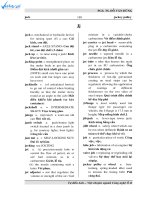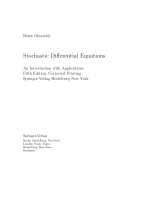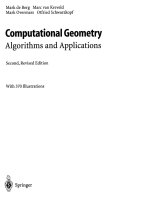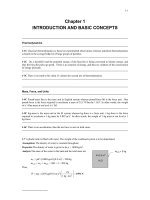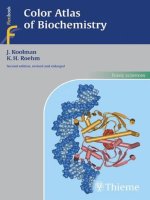Biochemistry 5th ed j berg, j tymoczko, l stryer (freeman, 2002)
Bạn đang xem bản rút gọn của tài liệu. Xem và tải ngay bản đầy đủ của tài liệu tại đây (45.41 MB, 1,438 trang )
Biochemistry Fifth Edition
0.1
Biochemistry Fifth Edition
Short Contents
Dedication
About the authors
Acknowledgments
I. The Molecular Design of Life
1. Prelude: Biochemistry and the Genomic Revolution
2. Biochemical Evolution
3. Protein Structure and Function
4. Exploring Proteins
5. DNA, RNA, and the Flow of Genetic Information
6. Exploring Genes
7. Exploring Evolution
8. Enzymes: Basic Concepts and Kinetics
9. Catalytic Strategies
10. Regulatory Strategies: Enzymes and Hemoglobin
11. Carbohydrates
12. Lipids and Cell Membranes
13. Membrane Channels and Pumps
II. Transducing and Storing Energy
14. Metabolism: Basic Concepts and Design
15. Signal-Transduction Pathways: An Introduction to Information Metabolism
16. Glycolysis and Gluconeogenesis
17. The Citric Acid Cycle
18. Oxidative Phosphorylation
19. The Light Reactions of Photosynthesis
20. The Calvin Cycle and the Pentose Phosphate Pathway
21. Glycogen Metabolism
22. Fatty Acid Metabolism
23. Protein Turnover and Amino Acid Catabolism
0.2
Biochemistry Fifth Edition
III. Synthesizing the Molecules of Life
24. The Biosynthesis of Amino Acids
25. Nucleotide Biosynthesis
26. The Biosynthesis of Membrane Lipids and Steroids
27. DNA Replication, Recombination, and Repair
28. RNA Synthesis and Splicing
29. Protein Synthesis
30. The Integration of Metabolism
31. The Control of Gene Expression
IV. Responding to Environmental Changes
32. Sensory Systems
33. The Immune System
34. Molecular Motors
Appendix A: Physical Constants and Conversion of Units
Appendix B: Acidity Constants
Appendix C: Standard Bond Lengths
Glossary of Compounds
Common Abbreviations in Biochemistry
0.3
Biochemistry Fifth Edition
Full Contents
Dedication
About the authors
Acknowledgments
I. The Molecular Design of Life
1. Prelude: Biochemistry and the Genomic Revolution
1.1. DNA Illustrates the Relation between Form and Function
1.2. Biochemical Unity Underlies Biological Diversity
1.3. Chemical Bonds in Biochemistry
1.4. Biochemistry and Human Biology
Appendix: Depicting Molecular Structures
2. Biochemical Evolution
2.1. Key Organic Molecules Are Used by Living Systems
2.2. Evolution Requires Reproduction, Variation, and Selective Pressure
2.3. Energy Transformations Are Necessary to Sustain Living Systems
2.4. Cells Can Respond to Changes in Their Environments
Summary
Problems
Selected Readings
3. Protein Structure and Function
3.1. Proteins Are Built from a Repertoire of 20 Amino Acids
3.2. Primary Structure: Amino Acids Are Linked by Peptide Bonds to Form Polypeptide
Chains
3.3. Secondary Structure: Polypeptide Chains Can Fold Into Regular Structures Such as
the Alpha Helix, the Beta Sheet, and Turns and Loops
3.4. Tertiary Structure: Water-Soluble Proteins Fold Into Compact Structures with
Nonpolar Cores
3.5. Quaternary Structure: Polypeptide Chains Can Assemble Into Multisubunit Structures
3.6. The Amino Acid Sequence of a Protein Determines Its Three-Dimensional Structure
0.4
Biochemistry Fifth Edition
Summary
Appendix: Acid-Base Concepts
Problems
Selected Readings
4. Exploring Proteins
4.1. The Purification of Proteins Is an Essential First Step in Understanding Their Function
4.2. Amino Acid Sequences Can Be Determined by Automated Edman Degradation
4.3. Immunology Provides Important Techniques with Which to Investigate Proteins
4.4. Peptides Can Be Synthesized by Automated Solid-Phase Methods
4.5. Three-Dimensional Protein Structure Can Be Determined by NMR Spectroscopy and
X-Ray Crystallography
Summary
Problems
Selected Readings
5. DNA, RNA, and the Flow of Genetic Information
5.1. A Nucleic Acid Consists of Four Kinds of Bases Linked to a Sugar-Phosphate
Backbone
5.2. A Pair of Nucleic Acid Chains with Complementary Sequences Can Form a DoubleHelical Structure
5.3. DNA Is Replicated by Polymerases that Take Instructions from Templates
5.4. Gene Expression Is the Transformation of DNA Information Into Functional
Molecules
5.5. Amino Acids Are Encoded by Groups of Three Bases Starting from a Fixed Point
5.6. Most Eukaryotic Genes Are Mosaics of Introns and Exons
Summary
Problems
Selected Readings
6. Exploring Genes
6.1. The Basic Tools of Gene Exploration
0.5
Biochemistry Fifth Edition
6.2. Recombinant DNA Technology Has Revolutionized All Aspects of Biology
6.3. Manipulating the Genes of Eukaryotes
6.4. Novel Proteins Can Be Engineered by Site-Specific Mutagenesis
Summary
Problems
Selected Reading
7. Exploring Evolution
7.1. Homologs Are Descended from a Common Ancestor
7.2. Statistical Analysis of Sequence Alignments Can Detect Homology
7.3. Examination of Three-Dimensional Structure Enhances Our Understanding of
Evolutionary Relationships
7.4. Evolutionary Trees Can Be Constructed on the Basis of Sequence Information
7.5. Modern Techniques Make the Experimental Exploration of Evolution Possible
Summary
Problems
Selected Readings
8. Enzymes: Basic Concepts and Kinetics
8.1. Enzymes Are Powerful and Highly Specific Catalysts
8.2. Free Energy Is a Useful Thermodynamic Function for Understanding Enzymes
8.3. Enzymes Accelerate Reactions by Facilitating the Formation of the Transition State
8.4. The Michaelis-Menten Model Accounts for the Kinetic Properties of Many Enzymes
8.5. Enzymes Can Be Inhibited by Specific Molecules
8.6. Vitamins Are Often Precursors to Coenzymes
Summary
Appendix: Vmax and KM Can Be Determined by Double-Reciprocal Plots
Problems
Selected Readings
0.6
Biochemistry Fifth Edition
9. Catalytic Strategies
9.1. Proteases: Facilitating a Difficult Reaction
9.2. Making a Fast Reaction Faster: Carbonic Anhydrases
9.3. Restriction Enzymes: Performing Highly Specific DNA-Cleavage Reactions
9.4. Nucleoside Monophosphate Kinases: Catalyzing Phosphoryl Group Exchange
between Nucleotides Without Promoting Hydrolysis
Summary
Problems
Selected Readings
10. Regulatory Strategies: Enzymes and Hemoglobin
10.1. Aspartate Transcarbamoylase Is Allosterically Inhibited by the End Product of Its
Pathway
10.2. Hemoglobin Transports Oxygen Efficiently by Binding Oxygen Cooperatively
10.3. Isozymes Provide a Means of Regulation Specific to Distinct Tissues and
Developmental Stages
10.4. Covalent Modification Is a Means of Regulating Enzyme Activity
10.5. Many Enzymes Are Activated by Specific Proteolytic Cleavage
Summary
Problems
Selected Readings
11. Carbohydrates
11.1. Monosaccharides Are Aldehydes or Ketones with Multiple Hydroxyl Groups
11.2. Complex Carbohydrates Are Formed by Linkage of Monosaccharides
11.3. Carbohydrates Can Be Attached to Proteins to Form Glycoproteins
11.4. Lectins Are Specific Carbohydrate-Binding Proteins
Summary
Problems
Selected Readings
0.7
Biochemistry Fifth Edition
12. Lipids and Cell Membranes
12.1. Many Common Features Underlie the Diversity of Biological Membranes
12.2. Fatty Acids Are Key Constituents of Lipids
12.3. There Are Three Common Types of Membrane Lipids
12.4. Phospholipids and Glycolipids Readily Form Bimolecular Sheets in Aqueous Media
12.5. Proteins Carry Out Most Membrane Processes
12.6. Lipids and Many Membrane Proteins Diffuse Rapidly in the Plane of the Membrane
12.7. Eukaryotic Cells Contain Compartments Bounded by Internal Membranes
Summary
Problems
Selected Readings
13. Membrane Channels and Pumps
13.1. The Transport of Molecules Across a Membrane May Be Active or Passive
13.2. A Family of Membrane Proteins Uses ATP Hydrolysis to Pump Ions Across
Membranes
13.3. Multidrug Resistance and Cystic Fibrosis Highlight a Family of Membrane Proteins
with ATP-Binding Cassette Domains
13.4. Secondary Transporters Use One Concentration Gradient to Power the Formation of
Another
13.5. Specific Channels Can Rapidly Transport Ions Across Membranes
13.6. Gap Junctions Allow Ions and Small Molecules to Flow between Communicating
Cells
Summary
Problems
Selected Readings
0.8
Biochemistry Fifth Edition
II. Transducing and Storing Energy
14. Metabolism: Basic Concepts and Design
14.1. Metabolism Is Composed of Many Coupled, Interconnecting Reactions
14.2. The Oxidation of Carbon Fuels Is an Important Source of Cellular Energy
14.3. Metabolic Pathways Contain Many Recurring Motifs
Summary
Problems
Selected Readings
15. Signal-Transduction Pathways: An Introduction to Information Metabolism
15.1. Seven-Transmembrane-Helix Receptors Change Conformation in Response to
Ligand Binding and Activate G Proteins
15.2. The Hydrolysis of Phosphatidyl Inositol Bisphosphate by Phospholipase C Generates
Two Messengers
15.3. Calcium Ion Is a Ubiquitous Cytosolic Messenger
15.4. Some Receptors Dimerize in Response to Ligand Binding and Signal by Crossphosphorylation
15.5. Defects in Signaling Pathways Can Lead to Cancer and Other Diseases
15.6. Recurring Features of Signal-Transduction Pathways Reveal Evolutionary
Relationships
Summary
Problems
Selected Readings
16. Glycolysis and Gluconeogenesis
16.1. Glycolysis Is an Energy-Conversion Pathway in Many Organisms
16.2. The Glycolytic Pathway Is Tightly Controlled
16.3. Glucose Can Be Synthesized from Noncarbohydrate Precursors
16.4. Gluconeogenesis and Glycolysis Are Reciprocally Regulated
Summary
Problems
Selected Readings
0.9
Biochemistry Fifth Edition
17. The Citric Acid Cycle
17.1. The Citric Acid Cycle Oxidizes Two-Carbon Units
17.2. Entry to the Citric Acid Cycle and Metabolism Through It Are Controlled
17.3. The Citric Acid Cycle Is a Source of Biosynthetic Precursors
17.4. The Glyoxylate Cycle Enables Plants and Bacteria to Grow on Acetate
Summary
Problems
Selected Readings
18. Oxidative Phosphorylation
18.1. Oxidative Phosphorylation in Eukaryotes Takes Place in Mitochondria
18.2. Oxidative Phosphorylation Depends on Electron Transfer
18.3. The Respiratory Chain Consists of Four Complexes: Three Proton Pumps and a
Physical Link to the Citric Acid Cycle
18.4. A Proton Gradient Powers the Synthesis of ATP
18.5. Many Shuttles Allow Movement Across the Mitochondrial Membranes
18.6. The Regulation of Cellular Respiration Is Governed Primarily by the Need for ATP
Summary
Problems
Selected Readings
19. The Light Reactions of Photosynthesis
19.1. Photosynthesis Takes Place in Chloroplasts
19.2. Light Absorption by Chlorophyll Induces Electron Transfer
19.3. Two Photosystems Generate a Proton Gradient and NADPH in Oxygenic
Photosynthesis
19.4. A Proton Gradient Across the Thylakoid Membrane Drives ATP Synthesis
19.5. Accessory Pigments Funnel Energy Into Reaction Centers
19.6. The Ability to Convert Light Into Chemical Energy Is Ancient
Summary
Problems
0.10
Biochemistry Fifth Edition
Selected Readings
20. The Calvin Cycle and the Pentose Phosphate Pathway
20.1. The Calvin Cycle Synthesizes Hexoses from Carbon Dioxide and Water
20.2. The Activity of the Calvin Cycle Depends on Environmental Conditions
20.3 the Pentose Phosphate Pathway Generates NADPH and Synthesizes Five-Carbon
Sugars
20.4. The Metabolism of Glucose 6-Phosphate by the Pentose Phosphate Pathway Is
Coordinated with Glycolysis
20.5. Glucose 6-Phosphate Dehydrogenase Plays a Key Role in Protection Against
Reactive Oxygen Species
Summary
Problems
Selected Readings
21. Glycogen Metabolism
21.1. Glycogen Breakdown Requires the Interplay of Several Enzymes
21.2. Phosphorylase
Phosphorylation
Is
Regulated
by
Allosteric
Interactions
and
Reversible
21.3. Epinephrine and Glucagon Signal the Need for Glycogen Breakdown
21.4. Glycogen Is Synthesized and Degraded by Different Pathways
21.5. Glycogen Breakdown and Synthesis Are Reciprocally Regulated
Summary
Problems
Selected Readings
22. Fatty Acid Metabolism
22.1. Triacylglycerols Are Highly Concentrated Energy Stores
22.2. The Utilization of Fatty Acids as Fuel Requires Three Stages of Processing
22.3. Certain Fatty Acids Require Additional Steps for Degradation
22.4. Fatty Acids Are Synthesized and Degraded by Different Pathways
0.11
Biochemistry Fifth Edition
22.5. Acetyl Coenzyme A Carboxylase Plays a Key Role in Controlling Fatty Acid
Metabolism
22.6. Elongation and Unsaturation of Fatty Acids Are Accomplished by Accessory
Enzyme Systems
Summary
Problems
Selected Readings
23. Protein Turnover and Amino Acid Catabolism
23.1. Proteins Are Degraded to Amino Acids
23.2. Protein Turnover Is Tightly Regulated
23.3. The First Step in Amino Acid Degradation Is the Removal of Nitrogen
23.4. Ammonium Ion Is Converted Into Urea in Most Terrestrial Vertebrates
23.5. Carbon Atoms of Degraded Amino Acids Emerge as Major Metabolic Intermediates
23.6. Inborn Errors of Metabolism Can Disrupt Amino Acid Degradation
Summary
Problems
Selected Readings
0.12
Biochemistry Fifth Edition
III. Synthesizing the Molecules of Life
24. The Biosynthesis of Amino Acids
24.1. Nitrogen Fixation: Microorganisms Use ATP and a Powerful Reductant to Reduce
Atmospheric Nitrogen to Ammonia
24.2. Amino Acids Are Made from Intermediates of the Citric Acid Cycle and Other
Major Pathways
24.3. Amino Acid Biosynthesis Is Regulated by Feedback Inhibition
24.4. Amino Acids Are Precursors of Many Biomolecules
Summary
Problems
Selected Readings
25. Nucleotide Biosynthesis
25.1. In de Novo Synthesis, the Pyrimidine Ring Is Assembled from Bicarbonate,
Aspartate, and Glutamine
25.2. Purine Bases Can Be Synthesized de Novo or Recycled by Salvage Pathways
25.3. Deoxyribonucleotides Synthesized by the Reduction of Ribonucleotides Through a
Radical Mechanism
25.4. Key Steps in Nucleotide Biosynthesis Are Regulated by Feedback Inhibition
25.5. NAD+, FAD, and Coenzyme A Are Formed from ATP
25.6. Disruptions in Nucleotide Metabolism Can Cause Pathological Conditions
Summary
Problems
Selected Readings
26. The Biosynthesis of Membrane Lipids and Steroids
26.1. Phosphatidate Is a Common Intermediate in the Synthesis of Phospholipids and
Triacylglycerols
26.2. Cholesterol Is Synthesized from Acetyl Coenzyme A in Three Stages
26.3. The Complex Regulation of Cholesterol Biosynthesis Takes Place at Several Levels
26.4. Important Derivatives of Cholesterol Include Bile Salts and Steroid Hormones
Summary
0.13
Biochemistry Fifth Edition
Problems
Selected Readings
27. DNA Replication, Recombination, and Repair
27.1. DNA Can Assume a Variety of Structural Forms
27.2. DNA Polymerases Require a Template and a Primer
27.3. Double-Stranded DNA Can Wrap Around Itself to Form Supercoiled Structures
27.4. DNA Replication of Both Strands Proceeds Rapidly from Specific Start Sites
27.5. Double-Stranded DNA Molecules with Similar Sequences Sometimes Recombine
27.6. Mutations Involve Changes in the Base Sequence of DNA
Summary
Problems
Selected Readings
28. RNA Synthesis and Splicing
28.1. Transcription Is Catalyzed by RNA Polymerase
28.2. Eukaryotic Transcription and Translation Are Separated in Space and Time
28.3. The Transcription Products of All Three Eukaryotic Polymerases Are Processed
28.4. The Discovery of Catalytic RNA Was Revealing in Regard to Both Mechanism and
Evolution
Summary
Problems
Selected Readings
29. Protein Synthesis
29.1. Protein Synthesis Requires the Translation of Nucleotide Sequences Into Amino
Acid Sequences
29.2. Aminoacyl-Transfer RNA Synthetases Read the Genetic Code
29.3. A Ribosome Is a Ribonucleoprotein Particle (70S) Made of a Small (30S) and a
Large (50S) Subunit
29.4. Protein Factors Play Key Roles in Protein Synthesis
0.14
Biochemistry Fifth Edition
29.5. Eukaryotic Protein Synthesis Differs from Prokaryotic Protein Synthesis Primarily in
Translation Initiation
Summary
Problems
Selected Readings
30. The Integration of Metabolism
30.1. Metabolism Consist of Highly Interconnected Pathways
30.2. Each Organ Has a Unique Metabolic Profile
30.3. Food Intake and Starvation Induce Metabolic Changes
30.4. Fuel Choice During Exercise Is Determined by Intensity and Duration of Activity
30.5. Ethanol Alters Energy Metabolism in the Liver
Summary
Problems
Selected Readings
31. The Control of Gene Expression
31.1. Prokaryotic DNA-Binding Proteins Bind Specifically to Regulatory Sites in Operons
31.2. The Greater Complexity of Eukaryotic Genomes Requires Elaborate Mechanisms for
Gene Regulation
31.3. Transcriptional Activation and Repression Are Mediated by Protein-Protein
Interactions
31.4. Gene Expression Can Be Controlled at Posttranscriptional Levels
Summary
Problems
Selected Readings
0.15
Biochemistry Fifth Edition
IV. Responding to Environmental Changes
32. Sensory Systems
32.1. A Wide Variety of Organic Compounds Are Detected by Olfaction
32.2. Taste Is a Combination of Senses that Function by Different Mechanisms
32.3. Photoreceptor Molecules in the Eye Detect Visible Light
32.4. Hearing Depends on the Speedy Detection of Mechanical Stimuli
32.5. Touch Includes the Sensing of Pressure, Temperature, and Other Factors
Summary
Problems
Selected Readings
33. The Immune System
33.1. Antibodies Possess Distinct Antigen-Binding and Effector Units
33.2. The Immunoglobulin Fold Consists of a Beta-Sandwich Framework with
Hypervariable Loops
33.3. Antibodies Bind Specific Molecules Through Their Hypervariable Loops
33.4. Diversity Is Generated by Gene Rearrangements
33.5. Major-Histocompatibility-Complex Proteins Present Peptide Antigens on Cell
Surfaces for Recognition by T-Cell Receptors
33.6. Immune Responses Against Self-Antigens Are Suppressed
Summary
Problems
Selected Readings
34. Molecular Motors
34.1. Most Molecular-Motor Proteins Are Members of the P-Loop NTPase Superfamily
34.2. Myosins Move Along Actin Filaments
34.3. Kinesin and Dynein Move Along Microtubules
34.4. A Rotary Motor Drives Bacterial Motion
Summary
Problems
Selected Readings
0.16
Biochemistry Fifth Edition
Appendix A: Physical Constants and Conversion of Units
Appendix B: Acidity Constants
Appendix C: Standard Bond Lengths
Glossary of Compounds
Common Abbreviations in Biochemistry
0.17
Biochemistry Fifth Edition
Dedication
TO OUR TEACHERS AND OUR STUDENTS
0.18
Biochemistry Fifth Edition
About the authors
JEREMY M. BERG has been Professor and Director (Department Chairperson) of Biophysics and
Biophysical Chemistry at Johns Hopkins University School of Medicine since 1990. He received his B.S.
and M.S. degrees in Chemistry from Stanford (where he learned X-ray crystallography with Keith
Hodgson and Lubert Stryer) and his Ph.D. in Chemistry from Harvard with Richard Holm. He then
completed a postdoctoral fellowship with Carl Pabo. Professor Berg is recipient of the American
Chemical Society Award in Pure Chemistry (1994), the Eli Lilly Award for Fundamental Research in
Biological Chemistry (1995), the Maryland Outstanding Young Scientist of the Year (1995), and the
Harrison Howe Award (1997). While at Johns Hopkins, he has received the W. Barry Wood Teaching
Award (selected by medical students), the Graduate Student Teaching Award, and the Professor's
Teaching Award for the Preclinical Sciences. He is co-author, with Stephen Lippard, of the text
Principles of Bioinorganic Chemistry.
JOHN L. TYMOCZKO is the Towsley Professor of Biology at Carleton College, where he has taught
since 1976. He currently teaches Biochemistry, Biochemistry Laboratory, Oncogenes and the Molecular
Biology of Cancer, and Exercise Biochemistry and co-teaches an introductory course, Bioenergetics and
Genetics. Professor Tymoczko received his B.A. from the University of Chicago in 1970 and his Ph.D. in
Biochemistry from the University of Chicago with Shutsung Liao at the Ben May Institute for Cancer
Research. He followed that with a post-doctoral position with Hewson Swift of the Department of
Biology at the University of Chicago. Professor Tymoczko's research has focused on steroid receptors,
ribonucleoprotein particles, and proteolytic processing enzymes.
LUBERT STRYER is currently Winzer Professor in the School of Medicine and Professor of
Neurobiology at Stanford University, where he has been on the faculty since 1976. He received his M.D.
from Harvard Medical School. Professor Stryer has received many awards for his research, including the
Eli Lilly Award for Fundamental Research in Biological Chemistry (1970) and the Distinguished
Inventors Award of the Intellectual Property Owners' Association. He was elected to the National
Academy of Sciences in 1984. Professor Stryer was formerly the President and Scientific Director of the
Affymax Research Institute. He is a founder and a member of the Scientific Advisory Board of Senomyx,
a company that is using biochemical knowledge to develop new and improved flavor and fragrance
molecules for use in consumer products. The publication of the first edition of his text Biochemistry in
1975 transformed the teaching of biochemistry.
0.19
Biochemistry Fifth Edition
Acknowledgments
There is an old adage that says that you never really learn a subject until you teach it. We now know that
you learn a subject even better when you write about it. Preparing the fifth edition of Biochemistry has
provided us with a wonderful opportunity to unite our love of biochemistry and teaching and to share our
enthusiasm with students throughout the world. Nonetheless, the project has also been a daunting one
because so many interesting discoveries have been made since the publication of the fourth edition. The
question constantly confronted us: What biochemical knowledge is most worth having? Answering this
question required attempting to master as much of the new material as possible and then deciding what to
include and, even harder, what to exclude.
However, we did not start from scratch. We feel both fortunate and intimidated to be writing the fifth
edition of Stryer's Biochemistry. Fortunate, because we had as our starting point the best biochemistry
book ever produced. Intimidated, because we had as our starting point the best biochemistry book ever
produced, with the challenge of improving it. To the extent that we have succeeded, we have done so
because of the help of many people.
Thanks go first and foremost to our students at Johns Hopkins University and Carleton College. Not a
word was written or an illustration constructed without the knowledge that bright, engaged students
would immediately detect vagueness or ambiguity. One of us (JMB) especially thanks the members of the
Berg lab who have cheerfully tolerated years of neglect and requests to review drafts of illustrations when
they would rather have been discussing their research. Particular thanks go to Dr. Barbara Amann and
Kathleen
Kolish who helped preserve some order in the midst of chaos. We also thank our colleagues at Johns
Hopkins University and Carleton College who supported, advised, instructed, and simply bore with us
during this arduous task. One of us (JLT) was graciously awarded a grant from Carleton College to
relieve him of some of his academic tasks so that he could focus more fully on the book.
We are also grateful to our colleagues throughout the world who served as reviewers for the new edition.
Their thoughtful comments, suggestions, and encouragement have been of immense help to us in
maintaining the excellence of the preceding editions. These reviewers are:
Mark Alper
University of California at Berkeley
L. Mario Amzel
Johns Hopkins University
Paul Azari
Colorado State University
Ruma Banerjee
University of Nebraska
Michael Barbush
Baker University
Douglas Barrick
Johns Hopkins University
Loran L. Bieber
Michigan State University
Margaret Brosnan
University of Newfoundland
Lukas K. Buehler
University of California at San Diego
C. Allen Bush
0.20
Biochemistry Fifth Edition
University of Maryland, Baltimore County
Tom Cech
Howard Hughes Medical Institute
Oscar P. Chilson
Washington University
Steven Clarke
University of California at Los Angeles
Philip A. Cole
Johns Hopkins University School of Medicine
Paul A. Craig
Rochester Institute of Technology
David L. Daleke
Indiana University
David Deamer
University of California at Santa Cruz
Frank H. Deis
Rutgers University
Eric S. Eberhardt
Vassar College
Duane C. Eichler
University of San Francisco School of Medicine
Stephen H. Ellis
Auburn University
Nuran Ercal
University of Missouri at Rolla
Gregg B. Fields
Florida Atlantic University
Gregory J. Gatto Jr.
Johns Hopkins University
Nancy Counts Gerber
San Francisco State University
Claiborne Glover III
University of Georgia
E. M. Gregory
Virginia Polytechnic Institute and State University
Mark Griep
University of Nebraska at Lincoln
Hebe M. Guardiola-Diaz
Trinity College
James R. Heitz
Mississippi State University
Neville R. Kallenbach
0.21
Biochemistry Fifth Edition
New York University
Harold Kasinsky
University of British Columbia
Dan Kirschner
Boston College
G. Barrie Kitto
University of Texas at Austin
James F. Koerner
University of Minnesota
John Koontz
University of Tennessee
Gary R. Kunkel
Texas A&M University
David O. Lambeth
University of North Dakota
Timothy Logan
Florida State University
Douglas D. McAbee
California State University at Long Beach
William R. Marcotte Jr.
Clemson University
Alan Mellors
University of Guelph
Dudley G. Moon
Albany College of Pharmacy
Kelley W. Moremen
University of Georgia
Scott Napper
University of Saskatchewan
Jeremy Nathans
Johns Hopkins University School of Medicine
James W. Phillips
University of Health Sciences
Terry Platt
University of Rochester Medical Center
Gary J. Quigley
Hunter College, City University of New York
Carl Rhodes
Howard Hughes Medical Institute
Gale Rhodes
University of Southern Maine
Mark Richter
0.22
Biochemistry Fifth Edition
University of Kansas
Anthony S. Serianni
University of Notre Dame
Ann E. Shinnar
Barnard College
Jessup M. Shively
Clemson University
Roger D. Sloboda
Dartmouth College
Carolyn M. Teschke
University of Connecticut
Dean R. Tolan
Boston University
Gordon Tollin
University of Arizona
Jeffrey M. Voigt
Albany College of Pharmacy
M. Gerard Waters
Princeton University
Linette M. Watkins
Southwest Texas State University
Gabriele Wienhausen
University of California at San Diego
James D. Willett
George Mason University
Gail R. Willsky
State University of New York at Buffalo
Dennis Winge
University of Utah
Charles F. Yocum
University of Michigan
Working with our colleagues at W. H. Freeman and Company has been a wonderful experience. We
would especially like to acknowledge the efforts of the following people. Our development editor, Susan
Moran, contributed immensely to the success of this project. During this process, Susan became a
committed biochemistry student. Her understanding of how the subject matter, text, and illustrations,
would be perceived by students and her commitment to excellence were a true inspiration. Our project
editor, Georgia Lee Hadler, managed the flow of the entire project—from manuscript to final product—
sometimes with a velvet glove and other times more forcefully, but always effectively. The careful
manuscript editor, Patricia Zimmerman, enhanced the text's literary consistency and clarity. Designers
Vicki Tomaselli and Patricia McDermond produced a design and layout that are organizationally clear
and aesthetically pleasing. The tireless search of our photo researchers, Vikii Wong and Dena Betz, for
the best possible photographs has contributed effectively to the clarity and appeal of the text. Cecilia
Varas, the illustration coordinator, ably oversaw the rendering of hundreds of new illustrations, and Julia
DeRosa, the production manager, astutely handled all the difficulties of scheduling, composition, and
manufacturing.
0.23
Biochemistry Fifth Edition
Neil Clarke of Johns Hopkins University, Sonia DiVittorio, and Mark Santee piloted the media projects
associated with the book. Neil's skills as a teacher and his knowledge of the power and pitfalls of
computers, Sonia's editing and coordination skills and her stylistic sense, and Mark's management of an
ever-changing project have made the Web site a powerful supplement to the text and a lot of fun to
explore. We want to acknowledge the media developers who transformed scripts into the animations you
find on our Web site. For the Conceptual Insights modules we thank Nick McLeod, Koreen Wykes, Dr.
Roy Tasker, Robert Bleeker, and David Hegarty, all at CADRE design. For the threedimensional
molecular visualizations in the Structural Insights modules we thank Timothy Driscoll (molvisions.com—
3D molecular visualization). Daniel J. Davis of the University of Arkansas at Fayetteville prepared the
online quizzes.
Publisher Michelle Julet was our cheerleader, taskmaster, comforter, and cajoler. She kept us going when
we were tired, frustrated, and discouraged. Along with Michelle, marketing mavens John Britch and
Carol Coffey introduced us to the business of publishing. We also thank the sales people at W. H.
Freeman and Company for their excellent suggestions and view of the market, especially Vice President
of Sales Marie Schappert, David Kennedy, Chris Spavins, Julie Hirshman, Cindi Weiss-Goldner,
Kimberly Manzi, Connaught Colbert, Michele Merlo, Sandy Manly, and Mike Krotine. We thank
Elizabeth Widdicombe, President of W. H. Freeman and Company, for never losing faith in us.
Finally, the project would not have been possible without the unfailing support of our families—
especially our wives, Wendie Berg and Alison Unger. Their patience, encouragement, and enthusiasm
have made this endeavor possible. We also thank our children, Alex, Corey, and Monica Berg and Janina
and Nicholas Tymoczko, for their forbearance and good humor and for constantly providing us a
perspective on what is truly important in life.
0.24
The Molecuclar Design of Life
Chapter 1 - Biochemistry and the Genomic Evolution
I. The Molecular Design of Life
Part of a lipoprotein particle. A model of the structure of apolipoprotein A-I (yellow), shown surrounding sheets of lipids. The
apolipoprotein is the major protein component of high-density lipoprotein particles in the blood. These particles are effective lipid
transporters because the protein component provides an interface between the hydrophobic lipid chains and the aqueous
environment of the bloodstream. [Based on coordinates provided by Stephen Harvey.]
1.1

